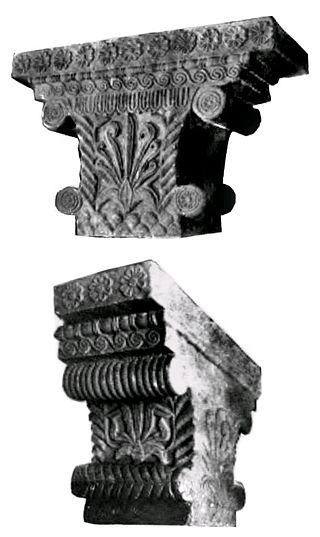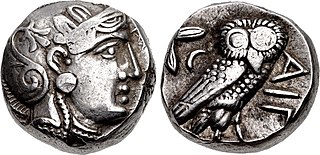
Demetrius I Anicetus, also called Damaytra was a Greco-Bactrian and later Indo-Greek king, who ruled areas from Bactria to ancient northwestern India. He was the son of the Greco-Bactrian Kingdom's ruler Euthydemus I and succeeded him around 200 BC, after which he conquered extensive areas in what is now southern Afghanistan, Iran and Pakistan and India.

The Maurya Empire, or the Mauryan Empire, was a geographically extensive Iron Age historical power on the Indian subcontinent based in Magadha, having been founded by Chandragupta Maurya in 322 BCE, and existing in loose-knit fashion until 185 BCE. The Maurya Empire was centralized by the conquest of the Indo-Gangetic Plain, and its capital city was located at Pataliputra. Outside this imperial center, the empire's geographical extent was dependent on the loyalty of military commanders who controlled the armed cities sprinkling it. During Ashoka's rule the empire briefly controlled the major urban hubs and arteries of the Indian subcontinent except those in the deep south. It declined for about 50 years after Ashoka's rule, and dissolved in 185 BCE with the assassination of Brihadratha by Pushyamitra Shunga and the foundation of the Shunga Empire in Magadha.

The Indo-Greek Kingdom, or Graeco-Indian Kingdom, also known historically as the Yavana Kingdom (Yavanarajya), was a Hellenistic-era Greek kingdom covering various parts of Afghanistan and the northwestern regions of the Indian subcontinent. This kingdom was in existence from ca. 200 BC to the beginning of the common era.

Apollodotus I Prakrit in the Kharoshti script: maharajasa apaladatasa tratarasa) was an Indo-Greek king between 180 BC and 160 BC or between 174 and 165 BC who ruled the western and southern parts of the Indo-Greek kingdom, from Taxila in Punjab to the areas of Sindh and possibly Gujarat.
The Shunga Empire was an ancient Indian dynasty from Magadha that controlled areas of the most of the northern Indian subcontinent from around 185 to 73 BCE. The dynasty was established by Pushyamitra, after taking the throne of the Maurya Empire. Its capital was Pataliputra, but later emperors such as Bhagabhadra also held court at Besnagar in eastern Malwa.

Brihadratha was the 9th and last Emperor of the Mauryan Empire. He ruled from 187 to 185 BCE, when he was killed by his general, Pushyamitra Shunga, who went on to establish the Shunga Empire. The Mauryan territories, centred on the capital of Pataliputra, had shrunk considerably from the time of Ashoka to when Brihadratha came to the throne.

The Coinage of India began anywhere between early 1st millennium BCE to the 6th century BCE, and consisted mainly of copper and silver coins in its initial stage. The coins of this period were Karshapanas or Pana. A variety of earliest Indian coins, however, unlike those circulated in West Asia, were stamped bars of metal, suggesting that the innovation of stamped currency was added to a pre-existing form of token currency which had already been present in the Janapadas and Mahajanapada kingdoms of the Early historic India. The kingdoms that minted their own coins included Gandhara, Kuntala, Kuru, Magadha, Panchala, Shakya, Surasena, Surashtra and Vidarbha etc.

The Triratna is a Buddhist symbol, thought to visually represent the Three Jewels of Buddhism.

Mauryan art is the art produced during the period of the Mauryan Empire, which was the first empire to rule over most of the Indian subcontinent, between 322 and 185 BCE. It represented an important transition in Indian art from use of wood to stone. It was a royal art patronized by Mauryan kings especially Ashoka. Pillars, Stupas, caves are the most prominent survivals.

The Nandipada is an ancient Indian symbol, also called a taurine symbol, representing a bull's hoof or the mark left by the foot of a bull in the ground. The nandipada and the zebu bull are generally associated with Nandi, Shiva 's humped bull in Hinduism. The Nandipada symbol also happens to be similar to the Brahmi letter "ma".

The Indo-Greeks practiced numerous religions during the time they ruled in present-day northwestern India from the 2nd century BCE to the beginning of the 1st century CE. In addition to the worship of the Classical pantheon of the Greek deities found on their coins, the Indo-Greeks were involved with local faiths, particularly with Buddhism, but also with Hinduism and Zoroastrianism.

Punch-marked coins, also known as Aahat coins, are a type of early coinage of India, dating to between about the 6th and 2nd centuries BC. It was of irregular shape. These coins are found are found over the most parts parts of subcontinent and remained in circulation till the early centuries CE.

The Achaemenid conquest of the Indus Valley occurred from the 6th to 4th centuries BCE, and saw the Persian Achaemenid Empire take control of regions in the northwestern Indian subcontinent that predominantly comprise the territory of modern-day Pakistan. The first of two main invasions was conducted around 535 BCE by the empire's founder, Cyrus the Great, who annexed the regions west of the Indus River that formed the eastern border of the Achaemenid Empire. Following Cyrus' death, Darius the Great established his dynasty and began to re-conquer former provinces and further expand the empire. Around 518 BCE, Persian armies under Darius crossed the Himalayas into India to initiate a second period of conquest by annexing regions up to the Jhelum River in Punjab.

Karshapana, according to the Ashtadhyayi of Panini, refers to ancient Indian coins current during the 6th century BCE onwards, which were unstamped and stamped (āhata) metallic pieces whose validity depended on the integrity of the person authenticating them. It is commonly supposed by scholars that they were first issued by merchants and bankers rather than the state. They contributed to the development of trade since they obviated the need for weighing of metal during exchange. Kārṣāpaṇas were basically silver pieces stamped with one to five or six rūpas ('symbols') originally only on the obverse side of the coins initially issued by the Janapadas and Mahajanapadas, and generally carried minute mark or marks to testify their legitimacy. Silver punch-marked coins ceased to be minted sometime in the second century BCE but exerted a wide influence for next five centuries.

Hellenistic influence on Indian art and architecture reflects the artistic and architectural influence of the Greeks on Indian art following the conquests of Alexander the Great, from the end of the 4th century BCE to the first centuries of the common era. The Greeks in effect maintained a political presence at the doorstep, and sometimes within India, down to the 1st century CE with the Greco-Bactrian Kingdom and the Indo-Greek Kingdoms, with many noticeable influences on the arts of the Maurya Empire especially. Hellenistic influence on Indian art was also felt for several more centuries during the period of Greco-Buddhist art.

The Post-Mauryan coinage of Gandhara refers to the period of coinage production in Gandhara, following the breakup of the Maurya Empire. When Mauryan central power disappeared, several small independent entities were formed, which started to strike their own coins, defining a period of Post-Mauryan coinage that ends with the rise of the Gupta Empire in the 4th century CE. This phenomenon was particularly precocious and significant in the area of Gandhara in the northwest, and more particularly in the city of Taxila, in modern-day Pakistan.

Post-Mauryan coinage refers to the period of coinage production in India, following the breakup of the Maurya Empire.

The Kabul hoard, also called the Chaman Hazouri, Chaman Hazouri or Tchamani-i Hazouri hoard, is a coin hoard discovered in the vicinity of Kabul, Afghanistan in 1933. The collection contained numerous Achaemenid coins as well as many Greek coins from the 5th and 4th centuries BCE. Approximately one thousand coins were counted in the hoard. The deposit of the hoard is dated to approximately 380 BCE, as this is the probable date of the least ancient datable coin found in the hoard.
Radhamitra, or Radhamita, was a king of Kosambi, the capital of one of the previously independent Indian Mahajanapadas known before as Vatsa. He was part of the Mitra dynasty, and was likely one of the earliest kings in the dynasty.

Mitra dynasty of Kosambi was centered on the city of Kosambi at the Vatsa region. Its capital Kosambi was among the most important trade centers in the ancient India. The dynasty also likely controlled territory in nearby regions such as Magadha.























